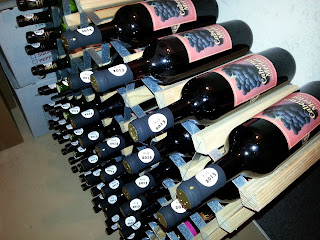Improving your
home winemaking
Like every home winemaker in the world, I’m eternally
striving to improve the quality of my wines. That’s not to say the quality is
low; quite the opposite actually. The quality is such that purchasing
commercial wines at $12 to $20 on average seems utterly wasteful given that my
wines are more like $2.50 to $3.00 per bottle and are easily comparable in
quality; and in at least 50% of cases, even better in my opinion. It’s not a ridiculous claim either, especially
when you consider how far wine kits have come.
Many people don’t realize that the juice in these kits is often pressed
from the same grapes as your favorite commercial wine; having been grown in the
same vineyards. I won’t go so far as to
name names, but it’s no secret that many of the world’s big wine brands also fall under the corporate structures of wine kit manufacturers. It’s a great way to profit from excess supply
from their vineyards. Add this to the
fact that before the ingredients arrive at your local shop they have been
scrutinized by professionals to ensure consistent quality. So with a little experience, the home
winemaker can achieve results like never before.
So where do you go when you feel like you’ve reached a point
where you’re consistently putting out top quality and stylistically correct
wines? And by that I mean your Cabernet Sauvignon tastes like Cabernet
Sauvignon and your Pinot Noir tastes like Pinot Noir and they don’t share an
underlying similarity with every other wine you make.
Two places you can and certainly should go if you’re an
experienced home winemaker are: 1) adapt fermentation schedules to the variety
and style of the wine you’re making; don’t just use a cookie cutter approach
the treat all wines the same. While
we’re at it, let’s throw various fermentation temperatures into the mix. Try fermenting each batch at different
temperatures according to style.
2) Switch out your yeast.
Most wine kits come equipped with EC – 1118 yeast as a standard. It’s hearty and foolproof and will produce
consistent results, but used across the board, your wines will all have a
similar tone. For the sake of a 99¢
packet of a different yeast strain, you can really make each batch unique. Plus you can now use your leftover packets of
1118 to make some nice bread. I’ve done it and it’s delicious.
All of this assumes of course that you’re ready and capable
of adapting carefully constructed kits to make them your own. This is NOT a trivial matter. These kits have a massive input of knowledge
and resources and changing them is a bit like modifying your car; you become
the engineer. The original design and
function has now been thrown out the window and you run an extremely likely
risk of making it worse, not better. How
do you know if you’re up to it? Do you
have winemaking notes and spreadsheets on every batch going back 10 years? Do you have a strange propensity to smell
everything? Do others plead with you to
share your wines with them, or do you have to place it in their hands? If you meet these criteria then go for it,
one batch at a time, changing one variable at a time.
Cheers
